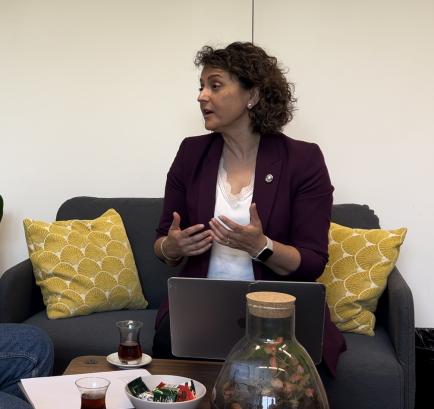
BIRMM Spotlight Interview: Measuring Irregular Migration with Professor Tuba Bircan
In this BIRMM Spotlight interview, we are pleased to welcome Professor Tuba Bircan, a distinguished sociologist and interdisciplinary computational social scientist, to discuss the MirreM project—an innovative European initiative aimed at improving the measurement of irregular migration and evaluating related policies.
Thank you for joining us today, Professor Bircan. Could you start by introducing yourself and the MirreM project?
Thank you, it’s great to be here. I’m based at the Department of Sociology at Vrije Universiteit Brussel (VUB), where I direct the Brussels Institute for Social and Population Studies (BRISPO) and lead the AIMS Lab, which focuses on AI, migration, and society. These roles connect directly to my involvement in MirreM—short for "Measuring Irregular Migration and Related Policies." The project aims to provide better estimates and understanding of irregular migration and to evaluate related policies across Europe. At VUB, we contribute particularly to the estimation of irregular migrant numbers, assessment of regularization and border control policies, and the development of innovative methodologies using unconventional data sources.
How long has the MirreM project been running?
It’s a three-year project, and we’re now in the final year. We’ll hold our final conference this September. The project builds on earlier work like the Clandestino project and aims to consolidate existing European and international efforts, including contributions from partners in countries such as Canada.
Could you summarize some of the main findings of the project?
Certainly. Despite being a coordination and support action project rather than a pure research initiative, MirreM has generated substantive outputs. We collaborated with academic and non-academic partners, as real-world insights are especially valuable when dealing with irregular migration—a field marked by data gaps and sensitivity.
Our work was organized around three pillars:
- Developing estimates for irregular migrant stocks and inflows across the EU.
- Evaluating related policies—including how irregularity is defined, externalization measures, and pathways to regularization.
- Innovating new methodologies to improve migration statistics.
At VUB, we pioneered a method using mortality data to estimate the number of undocumented migrants. By analyzing death records and linking them to population registries, we identified excess deaths potentially attributable to undocumented individuals. This method attracted attention from national statistics offices in Belgium, Spain, Austria, Sweden, and Eurostat, all interested in piloting or adapting it.
Were irregular migrants themselves involved in the project?
Directly, no. However, we collaborated closely with NGOs and organizations like PICUM and ICMPD, who work directly with undocumented migrants. Through them, we accessed indirect insights. While we didn’t conduct fieldwork with migrants ourselves, we did offer training sessions and engaged civil society to ensure their perspectives were represented. Since the project is more focused on policy and statistical frameworks than on individual lived experiences, this approach aligned with our goals.
You mentioned using mortality data. Why are people more forthcoming about a person’s migratory background after their death?
That’s a good question. Let me clarify: mortality data was just one of several sources we used, specifically within the innovation work package. In Belgium, we used death registries as a proxy. People tend to be more open about someone’s background after they’ve passed away, likely because there’s no longer a risk of harm or legal consequences. Additionally, the information is often gathered collectively—for example, by friends or community members during police or administrative procedures. It’s speculative, but we believe this openness is driven by reduced fear and perceived safety.
What do you hope your findings will achieve in terms of policy?
We’re very cautious about how our research might be used. Our aim is not to provide tools for more restrictive migration control but to enable better understanding and evidence-based policymaking. There’s a risk that data on irregular migration can be misused to justify hardline policies. For example, the European Commission once cited findings from several projects to argue for increased returns, even though our actual conclusions were different. In response, we and four other major projects issued a joint statement clarifying that our work had been misrepresented.
To clarify: irregular migration represents less than 10% of all migration in Europe. Yet it's often exaggerated in public and policy discourse to fuel fear and promote securitization. We advocate for policies that recognize the diversity of migrant journeys and needs—whether they came by boat, overstayed visas, or lost their legal status in other ways. Our findings support the need for more nuanced, humane, and evidence-informed policy approaches.
Thank you, Professor Bircan, for these valuable insights. A great way to conclude our conversation.
Thank you. It’s been a pleasure.
Watch the full interview with Tuba Bircan here:
